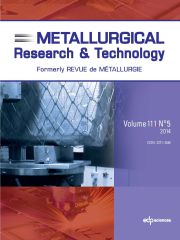No CrossRef data available.
Article contents
Spectres de réponse extrême et de dommage par fatigue. Utilisation pour l’écriture des spécifications d’environnement mécanique
Published online by Cambridge University Press: 10 May 2012
Abstract
The maximum (or extreme) response and fatigue damage spectra can be used for the severity comparison of several vibration with two criteria, the largest stress and the fatigue damage created on a linear one degree of freedom system. After defining these spectra, it is shown how they can be used to write a test specification from the life cycle profile of an equipment.
Keywords
- Type
- Research Article
- Information
- Copyright
- © EDP Sciences 2012
References
Basquin, O.H., The exponential law of endurance tests, Proceedings ASTM 10 (1910) 625-630 Google Scholar
C. Lalanne, Mechanical Vibration end Shock Analysis, Fatigue Damage, ISTE – Wiley, 2nd Ed., 2009, Vol. 4
D. Bonnet, C. Lalanne, Choix des essais, Analyse de l’environnement mécanique vibratoire réel en vue de l’élaboration de spécifications d’essais, Journées ASTE, 1977
C. Lalanne, Journal of the Environmental Sciences. Part I, July/August 1984, Vol. XXVII, Part II, September/October 1984, Vol. XXVII
G.H. Klein, A.G. Piersol, The development of vibration test specifications for spacecraft applications, N.A.S.A. CR - 234, 1965
Piersol, A.G., J. Sound Vib. 4 (1966) 88-115
G.E. Padgett, Formulation of realistic environmental test criteria for tactical guided missiles, I.E.S. Proceedings, 1968, pp. 441-448
M.G. Gens, The environmental operations analysis function. I.E.S. Proceeding, 1967, pp. 29-38
Guide d’application de la démarche de personnalisation en environnement mécanique, Norme Défense PR NORMDEF 0101, Édition 01, Juillet 2009
C. Lalanne, Mechanical Vibration end Shock Analysis, Specification Development, ISTE – Wiley, 2nd Ed., 2009, Vol. 5
P.G. Hahn, Shock and vibration considerations in flight vehicle system design.I.E.S. Proceeding, 1963, pp. 401-415
R.N. Hancock, Development of specifications from measured environments.Society of Environmental Engineers, Buntingford, Herts, G.B., S.E.E. Symposium, 1979, Vol. 1, pp. 1-16
A.G. Piersol, Criteria for the optimum selection of aerospace component vibration test levels.I.E.S. Proceeding 1974, pp. 88-94
J.W. Schlue, The dynamic environment of spacecraft surface transportation.N.A.S.A., Technical Report, 1966, pp. 32-876
Rosenbaum, E.S., Gloyna, F.L., Shock Vib. Bulletin 52 (1982) 159-228
Kachadourian, G., Shock Vib. Bulletin 37 (1968) 173-203
M. Coquelet, Progrès dans l’élaboration des programmes d’essais d’environnement mécanique, AGARD Conference Proceeding Vol. 318, pp. 10-81
J.T. Foley, Environmental analysis.I.E.S. Proceedings, 1962, pp. 427-431
Foley, J.T., Shock Vib. Bulletin 35 (1965) 57-70
Caillot, M.P., Revue des Laboratoires d’Essais 3 (1985) 9-11
C. Lalanne, Mechanical Vibration end Shock Analysis, Mechanical Shock, ISTE – Wiley, 2nd Ed., 2009, Vol. 2
C. Lalanne, Mechanical Vibration end Shock Analysis, Random Vibration, ISTE – Wiley, 2nd Ed., 2009, Vol. 3
J.T. Foley, An environmental research study.I.E.S. Proceeding, 1967, pp. 363-373
E.F. Small, A unified philosophy of shock and vibration testing for guided missiles.Proceedings I.E.S., 1956, pp. 277-282
Felgar, R.P., Vib. Associated Environments Bulletin 27 (1959) 113-125
Kroeger, R.C., Hasslacher, G.J., Shock Vib. Bulletin 31 (1962) 49-63
R.L. Racicot, Random vibration analysis, Application to wind loaded structures, Solid Mechanics, Structures and Mechanical Design Division Report No. 30, Case Western Reserve University, Ph.D. Thesis, 1969
R.F. Schoof, How much safety factor? Allis, Charmers Electrical Review, First Quarter, 1960, pp. 21-14
G.H. Howell, Factors of safety and their relation to stresses loads materials, Machine Design, 1956, pp. 76-81
C. Lalanne, Spécifications d’essais en environnement et coefficients de garantie, CEA/DAM/CESTA/DT/EX/MEV 1089, 1987
C. Lalanne, Personalization and safety factor. Institute of Environmental Sciences Proc., 1989, ou Coefficient de garantie, Symposium ASTE 1989 : La Norme Interarmées GAM EG13, Personnalisation des Essais en Environnement, 7/8 juin 1989, Paris
Report on structural safety. Structural Engineer, 1955, Vol. 33, pp. 141-149
R.E. Blake, J. Spacecraft Rockets 4 392-398
R.E. Blake, W.S. Baird, Derivation of design and test criteria.Proceedings I.E.S., 1969, pp. 128-138
R. Cestier, J.P. Garde, Étude des lois de distribution de la résistance mécanique des métaux. Interprétation de 3500 essais américains, CEA/DAM/ICQ/CESTA, DO 631, 18, 1977
R.L. Barnoski, The maximum response of a linear mechanical oscillator to stationary and nonstationary random excitation, NASA CR 340, 1965
C. Lalanne, Séismes, Comparaison de la sévérité des spécifications. La Revue des Laboratoires d’Essais, Très basses fréquences, 1988


